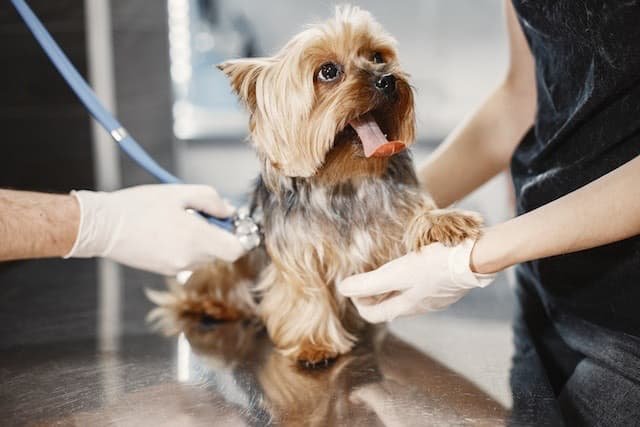TABLE OF CONTENTS
Sporadic Acute Exertional Rhabdomyolysis in Horses
Sporadic Acute Exertional Rhabdomyolysis in Horses is a most common cause is performing exercise of unaccustomed intensity or duration, which can result in metabolic exhaustion and hyperthermia.

Sporadic Acute Exertional Rhabdomyolysis in Horses also known as Azoturia and Tying-up.
Etiology
The etiology of most cases of sporadic acute exertional rhabdomyolysis is unknown although suggested causes include: hypothyroidism, sodium or potassium deficiency, viral infection, high carbohydrate diets, and abnormalities in metabolic function.
Epidemiology
- Occurrence: Clinical signs occur in horses within minutes to hours of the cessation of exercise, although signs can be apparent in horses during prolonged exercise.
- Breed / use groups : polo horses are approximately 3 times more likely to developthe disease than are horses used for racing
- Sex: Female race horses are three times more likely to have episodes of exertional rhabdomyolysis than are male (intact or castrated) race horses
- Age: young, female Thoroughbreds are at greatest risk
- Risk factors for exertional rhabdomyolysis include exercise, breed and use, and sex. Overall, horses that exercise are approximately 10 times more likely to develop the disease than are sedentary horses.
Pathogenesis
- The disease is due to dysfunction and death of myocytes with subsequent release of cellular constituents, including the enzymes Creatine Kinase, Aspartate Amino Transferase and Carbonic Anhydrase, and myoglobin.
- The proximate cause of myocyte death is uncertain, but is not related to accumulation of lactic acid, as previously supposed.
- Proposed mechanisms include oxidant injury to cells as a result of increased oxidant formation during exercise or inadequate antioxidant activity.
- Apart from horses deficient in vitamin E and / or selenium, which are rare, there is no indication that oxidant injury is a common cause of rhabdomyolysis in horses.
- Cell death is likely linked to abnormal accumulation of calcium in intracellular fluids secondary to deranged energy and/or membrane function.
- Necrosis of myocytes caused pain and inflammation in the muscle, with infiltration of inflammatory cells.
- Healing and regeneration of myocytes occurs over a period of weeks in the absence of further episodes of myonecrosis.
- Release of cellular constituents results in electrolyte abnormalities, primarily a hypochloremic metabolic alkalosis, a systemic inflammatory response, and pigmenturia.
- Severely affected horses can have a metabolic acidosis.
- Myoglobin, and possibly other cell constituents, are nephrotoxic and acute renal failure can develop as a result of myoglobinuric nephrosis.
- Pain and loss of muscle function cause a stilted, short stepping gait.
Clinical Signs
- Signs will vary from Poor performance to recumbency and death.
- Signs can be mild and Resolve spontaneously within 24 h or be severe and progressive.
- Does not perform to expectation and displays a stiff or short stepping gait that may be mistaken for lower leg lameness.
- Reluctant to move when placed in its stall, anorexic, paw, and frequently shift its weight.
- Severely affected horses may be recumbent
More severely affected horses can be unable to continue to exercise, have hard and painful muscles (usually gluteal muscles):
- Excessive Sweat
- Tremble or have widespread muscle fasciculations
- Refuse to walk
- Elevated heart and respiratory rates
- Hyperthermic, especially soon after exercise
- Abdominal pain
- Deep red urine (myoglobinuria) occurs but is not a consistent finding
Clinical Pathology
- Mildly or inapparently affected horses have moderate increases in serum creatine kinase (CK) (20 000-5 0 000 IU/L), Aspartate amino transferase (AST), and lactate dehydrogenase (LDH) activity.
- Severely affected horses have large increases in CK (>100 000 IU/L) and other muscle-derived enzymes.
- Serum CK and AST activities peak approximately 5-6 and 24 h after exercise, Serum myoglobin concentrations increase markedly during exercise in affected horses, and decline within 24-48 hrs
- Serum carbonic anhydrase III activity is increased in horses with exertional rhabdomyolysis
- Hyponatremic (<130 mEq/L), hyperkalemic (>5.5 mEq/L), hypochloremic (< 90 mEq/L), azotemic (increased serum urea nitrogen and creatinine concentrations), and acidotic or alkalotic.
- Hemoconcentration (hematocrit >50%) and increased serum total protein concentration (>80 g/L) indicative of dehydration are common
- Myoglobinuria is detectable either grossly or on chemical analysis
Muscle Biopsy
During the acute or convalescent stages reveals myonecrosis of Type II (fast twitch, oxidative) fibers, mild myositis, and fibrosis.
Treatment
The treatment chosen depends on the severity of the disease.
The general principles are rest, correction of dehydration and electrolyte abnormalities, prevention of complications including nephrosis and laminitis, and provision of analgesia.
In mildly affected cases:
- Heart Rate <60 BPM, Normal rectal temperature and respiratory rate, no dehydration.
- Treated with rest and Phenylbutazone (2.2 mg/kg, orally or every 12 hours for 2-4 days).
- Horses should be given mild exercise with incremental increases in workload as soon as they no longer have signs of muscle pain.
- Access to water should be unrestricted.
In severely affected cases:
- Heart rate >60 BPM, rectal temperature >39°C (l02°F), 8-10% dehydrated, reluctant or unable to walk.
- Should not be exercised, including walking back to their stable, unless it is unavoidable.
- Isotonic, polyionic fluids, such as lactated Ringer’s solution, should be administered to severely affected horses to correct any hypovolemia and to insure a mild diuresis to prevent myoglobinuric nephropathy.
In less severely affected cases:
- Treated by administration of fluids by nasogastric intubation (4-6 litres every 2-3 hours).
- Although it has been recommended that urine should be alkalinized by administration of mannitol and sodium bicarbonate (1.3% solution Iv, or 50-100 g of sodium bicarbonate orally every 12 hours) to minimize the nephrotoxicity of myoglobin, this therapy is not effective in humans at risk of myoglobinuric nephrosis.
- Affected horses should not be given diuretics (e .g. Furosemide).
Other treatment:
- Phenylbutazone (2.2-4.4 mg/kg, N or orally, every 12-24 h), flunixin meglumine (1 mg/kg N every 8 h) or ketoprofen (2.2 mg/kg N every 12 h) should be given to provide analgesia.
- Mild sedation (acetylpromazine 0.02-0.04 mg/kg IM, or xylazine, 0.1 mg/kg IM, both with butorphanol, 0.01 to 0.02 mg/kg) may decrease muscle pain and Anxiety.
- Muscle relaxants, such as methocarbamol, are often used but have no demonstrated Efficacy.
- Recumbent horses should be deeply bedded and repositioned by rolling every 2-4 hour.
- Severely affected horses should not be forced to stand.
Control
- Horses are often supplemented with 1 IU/kg vitamin E and 2.5 mg/kg selenium daily in the feed.
- Sodium bicarbonate (up to 0.5 to 1.0 g/kg body weight daily in the ration)
- Phenytoin has proven useful in the treatment of recurrent rhabdomyolysis. It is administered to horses for months.
- Dimethylglycine, dantrolene, altrenogest, and progesterone are all used on occasion in horses with recurrent rhabdomyolysis
- The feeding of high fat, low soluble carbohydrate diets is useful in the prevention

